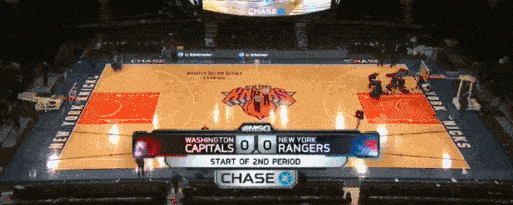Buzzing about the NBA re-start in 2020, I was on League Pass watching one of the scrimmage warm up games in Disney World, Florida. I noticed that every time play changed ends the sound of 10 giant humans sprinting up the court was very noticeable. It got me thinking, what are NBA courts made of?
What are NBA Basketball courts made of? NBA courts are made from acer saccharum, better known as ‘hard maple’. This is sourced from forests in the upper Midwest of North America. The only NBA team that do not play on a hard maple floor are the Boston Celtics, who traditionally use Red Oak for their distinctive floor. The maple is the traditional thickness of around 2cm or just over ¾ of an inch. This is how Maple floors have been sized since the 1800’s. NBA floor specifications require a 120 feet x 60 feet (36.6 x 18.3 meters) wood surface with a 94 feet x 50 feet (28.7 x 15.2 meters) painted basketball court. This is typically produced in smaller interlocking sections that can be expertly put together to ensure a perfect finish.

Is that it? Just some wood? Well yes, to some extent. However, there’s a lot more that goes into creating the most iconic playing surfaces in sports history. Read on to find out about who supplies the material, what characteristics the NBA looks for in its floors, how they affect player performance and how often they need to be maintained. Let’s start with that Disney Bubble…
What is the NBA Bubble floor made of?
The ‘NBA Bubble’ is housed within the Disney World ESPN World Wide Sports Complex in Florida. Before the NBA moved in to finish off the regular season and host the 2020 NBA Playoffs it already contained 7 hardwood courts the NBA had earmarked for practice. It was calculated that they needed to an additional 7 practice courts, two half courts, and three custom sized game floors to host the broadcasted games, adjusted for thew social distancing measures and absence of spectators.
Leaning on its shared resources the (relatively) nearby Miami Heat and the Orlando Magic each provided their two floors, in addition the Indiana Pacers donated their main floor to be used as practice courts while the field house undergoes a closed season refit.
This left the NBA short by 2 practice courts, two half-courts, and the all-important 3 custom game courts. These were produced by one of the NBA’s suppliers, Horner and are made of the same Hard Maple specifications as most NBA teams use in their arenas.
What are the costs and time scales to make an NBA court?
Including shipping it costs about $120,000 to supply an NBA standard court. Taking about 3 weeks in total to produce. The NBA’s main suppliers of court floors are Horner, Robbins and Connor Sports Flooring. It is required that an NBA court is changed every 10 years, although teams can apply for year on year extensions after inspection. Some lasting as long as 20 years!
Why are NBA courts made of hard maple wood?
NBA floors are made of hard maple wood because of several factors. It is one of the hardest woods giving durability and strength, it has a tight grain giving it a distinct and neat presentation and it is light in colour. Given the NBA is as much an entertainment business as it is a Sports League the lightness in colour of the wood is very important. It allows the ball to be seen better by players, fans and officials, while reflecting more light, brightening arenas and allowing that glossy shine that can be seen on TV. For anyone players reading who have been lucky enough to walk or even play on a high end wooden floor, let alone an NBA one you’ll know how premium it feels.
Do NBA wooden floors affect performance?
The answer to this is most definitely yes. It is not just the lightness, pattern and visual design of the NBA floor that teams can control when ordering it. They can also control the way it feels to walk, jump and run on and how the ball feels bouncing on it. Each manufacturer has its own patented subflooring system they can offer to teams. These consist of everything from plywood builds to specialized cushioning systems that give the floor a different feel. The more energy the floor absorbs the less energy is returned to the player. It has been likened to running on sand, if there is to much cushioning. This can be tailored to what the organisation, maybe even star players, prefer. Some franchises opt for no cushioning options at all.
As a final flourish, NBA courts are finished with a high gloss polyurethane used to ensure the court has a controlled and even grip throughout. It is vital that these finely tuned athletes can trust the ground underneath them, so they can focus on the task at hand – getting buckets. Each floor’s coefficient of friction is between 0.5 and 0.7. Anything outside this range starts to become to sticky or to slippery.
Each manufacturer will provide extensive aftersales care for these flagship products. Horner – who supplied the NBA courts for the 2020 Orlando Bubble -even had engineers living within the Bubble to ensure each floor can be inspected and treated to ensure maximum performanc.

